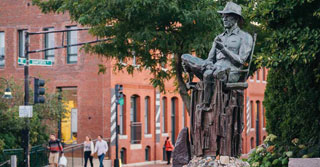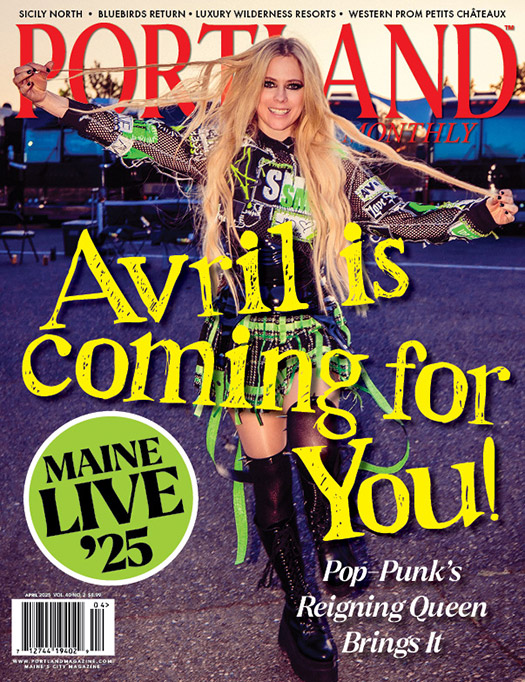February/March 2018 | view this story as a .pdf
It’s time we met the John Ford you never knew.
By Colin W. Sargent
 Spoiler alert. Here are two scenes from a movie local director John Ford never shot, because he lived them.
Spoiler alert. Here are two scenes from a movie local director John Ford never shot, because he lived them.
Scene No. 1: It’s 1954, and Maureen O’Hara is on the set of The Long Gray Line, about West Point cadets and their leaders. “I walked into his office without knocking and could hardly believe my eyes. Ford had his arms around another man and was kissing him. I was shocked and speechless. I quickly dropped the sketches on the floor, then knelt down to pick them up. I fumbled around slowly and kept my head down. I took my time so they could part and compose themselves. They were on opposite sides of the room in a flash.”
Tyrone Power played the male lead in the film.
Scene No. 2: It’s 1936. Katharine Hepburn is crazy in love with her director, John Ford. They’ve fallen in love. We see Katharine at her desk, carefully writing “a personal letter to [Ford’s wife, Mary McBride Ford], offering her $150,000 if she would divorce Ford and let him keep custody of Barbara, the daughter to whom he was particularly close.”
“Mary refused,” writes Nancy Schoenberger, author of Wayne and Ford, The Films, the Friendship, and the Forging of an American Hero (Nan A. Talese/Doubleday, $27.95), a book that’s touched off a global reassessment of Ford and his motivations just as sexual harassment revelations are erupting throughout the country. The point of mythic convergence: What is a “man,” and how have we been conditioned to expect “men” to behave? That is, is being a man fake news?
According to The Atlantic, “Shoenberger has hidden a provocative thesis inside a Christmas present for Dad…From the bulk of the evidence here, masculinity (like the Western) is a by-product of nostalgia, a maudlin elegy for something that never existed–or worse, a masquerade that allows no man, not even John Wayne, to be comfortable in his own skin. In the long working ‘friendship’ between the two men, unless I missed it, Ford never spared a kind word for his protégé. In fact, Ford was savage in his mistreatment of Wayne, even though–or because–Wayne worshipped him.”
The New York Times chimes in: “‘John Ford and John Wayne taught us how to be men,’ the director John Milius observes in the opening pages of Wayne and Ford. Schoenberger spends much of her swiftly paced, elegantly written book trying to unlock why.”
Ford might have cultivated the image that he was a cowboy director, but he was far more psychosexually complex, Schoenberger, a professor at The College of William and Mary, suggests. The Ford/Wayne redefinition of cinematic manhood wasn’t a creative conspiracy so much as an act of fear and self doubt under cover.
We reached Schoenberger to help Portlanders get to know the real Ford better.
1.To what extent is Ford a ‘European’ director? He’s credited with bringing German Expressionism, with its low-key, dramatic lighting, into Westerns, not to mention How Green Was My Valley and The Grapes of Wrath.
I don’t think of Ford as a “European director,” though he was influenced by the German Expressionists, especially F.W. Murnau [Nosferatu], as seen in his use of dramatic lighting and fog in The Informer and elsewhere. Like all artists, he was a great borrower–he took what he needed and made it his own. Rather, in bringing the Western along from a mostly matinee, shoot-’em-up for kids to a vehicle for grown-up themes, he pioneered a quintessentially American art form.
2. The end of The Searchers is cosmic. John Wayne’s Ethan Edwards is a nowhere man, stepping into infinity. He knows he’ll never come in for a landing. I saw it recently, and it struck me: Is The Misfits indebted to The Searchers?
You draw an interesting comparison between John Huston’s The Misfits (written by Arthur Miller) and The Searchers. I haven’t seen The Misfits in a long while, and don’t know if Huston or Miller had Ford’s film in mind, but both have an autumnal feel–the end of the wildness of the West (a theme Ford also explores in The Man Who Shot Liberty Valance). The only things really wild in The Misfits are the mustangs, and as I recall, there’s a feeling that the characters are already all used up. Ethan Edwards, who represents that wildness in The Searchers, is out of place and nearly out of time, as the West increasingly belongs to the homesteaders, the farmers, the ranchers.
3. That famous threshold image that opens and closes The Searchers…
Yes, it’s a powerful and influential image, seen most recently in the 2017 Western Hostiles–which I have yet to see, but in the trailer it shows a cowboy framed in just the same way. I suggest that Ford may have borrowed the image from Michael Powell and Emeric Pressburger’s wonderful 1945 film I Know Where I’m Going, where the heroine (Wendy Hiller) is twice framed in doorways, signifying life-changing decisions. That’s purely speculation on my part, and come to think of it, we see a powerful threshold image in Stagecoach, released in 1939.
4. Regarding the echoes of working-class Portland, my book was limited to the Ford-Wayne Westerns, so I don’t really explore How Green Was My Valley or The Quiet Man, but Ford once said that the Welsh setting for Valley could have stood in for any Irish town, and of course The Quiet Man reflects his fascination and pride in his Irish immigrant roots. The protagonist, Sean Thornton–a boxer!–played by John Wayne, is an alter ego for Ford (Sean being an Irish equivalent of John). Ford did love boxers, and that’s part of the appeal of Victor McLaglen, who won an Oscar for The Informer, and who then appeared in mostly comic roles in Ford’s cavalry trio. Clearly, there was a love of the gusto and camaraderie in saloons–preferably frequented by Irish and Irish immigrants, which he grew up with in Portland where his father owned a bar.
5 Quentin Tarantino has had some rough things to say about Ford–when he isn’t stealing his memorable shots. What’s behind the hate? Also, in Birth of a Nation, one of the Klansmen lifts his hood to improve his view. We see it’s the young John Ford, in an early acting role. It’s a chilling image. What was your reaction when you looked into this, and how should Ford’s fans regard it?
Regarding Tarantino’s remarks and the idea of Ford as a racist, I think the opposite is [also] true. Though the Apaches and Commanches and other marauding tribes of Native Americans are conveniently used in his early Westerns [especially Stagecoach] as generic enemies to be slaughtered, he came to regret his depiction of Indian people. His late Western, Cheyenne Autumn, told a tale from the point of view of the Cheyenne Nation, showing their mistreatment by the U.S. Bureau of Indian Affairs. “I’ve killed more Indians than Custer. This is their side,” he said about the film.
He was probably sensitized by working with the Navajos on their reservation in Monument Valley. He came to respect and even love the Navajo people, using them as extras and paying them handsomely, which helped them weather some brutal winters. He was proud of his friendship with them. In Rio Grande, though the Indians are adversaries, Ford takes pains to show some of their rituals and customs in an accurate light. Even earlier, in his great silent film The Iron Horse, though he depicts the Indians as enemies of the completion of the transcontinental railroad, in one scene he humanizes an Indian brave by showing a dog lying his head on a slain warrior, mourning his death.
Ford was also proud of the fact that he was among the first directors to give an African American actor, the wonderful Woody Strode, a lead role in a major American film, Sergeant Rutledge. The movie’s plot, a black Buffalo Soldier in the U.S. Cavalry wrongfully accused of the rape and murder of a white girl, was very much ahead of its time. Rutledge flees, knowing he won’t get a fair trial because of his race. A student of American history, Ford schools us on the black cavalry officer: Congress created the Buffalo Soldiers cavalry unit after the end of the Civil War in recognition that most black soldiers had no home to return to after the war. In the movie, Rutledge realizes that his fellow cavalry soldiers are the only home he knows, hence he returns to stand trial.
6. Regarding Ford and Wayne “tweaking the conventions of what a ‘man’ is today,” I think Ford, having grown up with brothers he idolized, in a rough-and-tumble world of boxers, drinkers, and roustabouts, found his deepest theme in male camaraderie, especially in the military, one of the few places where men can express their love for other men. But he was concerned with men acting heroically, thus the most macho guy was not always the most heroic. McLaglen often presented the comic side of blustery masculinity. Ford brought out Wayne’s tenderness as well as his toughness, especially in Stagecoach.
7. Among the Westerns, the prostitute Dallas (Claire Trevor) in Stagecoach breaks your heart with her humanity and her yearning. She is a fully realized character, as is Maureen O’Hara in Fort Apache, fighting to save her young son from combat in the Indian Wars, warring with her estranged husband–played by Wayne, of course–whom she still loves.
8. Ford’s happiest moments?
I’d say out on location in stark Monument Valley, listening to the coyotes in the distance heard over the strains of Danny Borzage playing “We Shall Gather at the River” on his accordion, his cast and crew around him, the studio moguls hundreds of miles away and thus non-interfering, the crepuscular light bouncing off the rock formations in the distance. Or aboard his yacht, The Araner , with his buddies John Wayne and Ward Bond, fishing and drinking. Drinking.
9. To the extent that moviegoers are searchers, can Ford’s movies guide us to a more thoughtful understanding of our roles in the 21st century?
I think Ford did try to grapple with the idea of what constituted heroic action–mostly in men but also in women–and what could save men from what I call testosterone poisoning [though he would never have used that term!]. He loved the company of masculine men, but he knew a bully when he saw one. Ethan Edwards is one of his most challenging figures in that he is a bully, a racist, an example of toxic masculinity, but is humanized at the end of the movie when he changes his entire direction [I won’t give away the ending for those who have not yet seen this great film!]. In a sense, for whatever reason, as it’s not spelled out, Edwards/Wayne admits he has been fundamentally wrong and offers–through his actions–a life-changing apology. But it comes too late for him and he’s cast out of paradise.





0 Comments